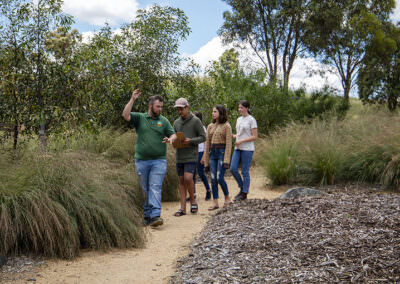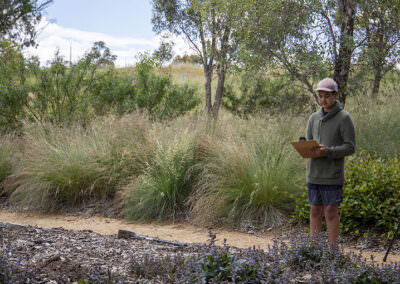
Creating an Indigenous plant-use garden: resources from the bush
Time Allocation: 40 minutes*
Activity Level: Complex
Introduction
This activity explores the importance of plants for Aboriginal and Torres Strait Islander peoples who know and understand the plants, life cycles, seasons, and the different ways plants are used. Care must be taken when interacting with plant materials. Correct plant identification is crucial to knowing which plants are edible and which are best to avoid.
This is a great opportunity to invite your local Traditional Owners take you on a guided walk so they can share their deep knowledge, connection and understanding of the land, stories and culture specific for your area. This is also a great way for starting to build relationships with your local First Nations community for the future, and take action towards reconciliation. Growing your garden will grow these partnerships even further.
*Time allocation will be dependent on site selection and travel time. Learners may visit bushland or look at native plants in the school garden, local park or reserve.
Checklist
Instructions
 STEP 1
STEP 1
Preparing
For many thousands of years, Aboriginal and Torres Strait Islander peoples have depended on the bush for everything they needed to survive.
The materials that a plant provided would depend on the different times of the year. Different parts of a plant were used for a variety of purposes. The different plant parts used included the root, leaf or shoot, flower, fruits, seeds, stems or wood.
Before you go on your walk, you may like to explore some of the field guides and resources. Using the Aboriginal and Torres Strait Islander Plant use in South Eastern Australia and Aboriginal and Torres Strait Islander Plant use and technology (or a local guide for plants local to your area) will help you to identify some of the plants on your walk and what they are used for.
Having a First Nations person guide you on your walk is even better as they can explain how the plants are used and share stories and culture.
 STEP 2
STEP 2
Exploring
Begin this activity at your location with an Acknowledgement of Country. By acknowledging the Land, you are also making a promise that you will care for the Land, the waterways, the plants and the animals.
Complete the Whose Country are you on? learning activity to determine your local First Nations language group.
Explore a bushland area close by and complete the activity sheet by drawing the different plant parts that you found on your walk. You may also like to take photos.
While you are on your walk, use your senses to observe your surroundings. What do you see, smell, hear, feel?
 STEP 3
STEP 3
Observing
Dependent on the time of year, you may not see flowers, fruits or seeds. Look for examples of seed pods, dried fruits or flowers on the ground.
If you haven’t seen any flowers, fruits or seeds, think about how other parts of the plants (bark and the wood) may be used.
 STEP 4
STEP 4
Identifying
Using the plant field guides or online resources in the resource list, identify the plants that you have observed and recorded in your activity sheet.
This is a great time to consider if any of these plants would be suitable to include in your plant-use garden.
Research further information about the plants observed and how they can be used as food and fibre. Complete the activity sheet, write about the food and fibre use and include a climate zone. The climate zone will help determine its suitability for your location.
Make sure you ask questions of your guide to help increase your understanding and knowledge.
Extension Activity
Extension 1
Using the plants included in the plant list activity in this series, create your own plant identification guide or informative sign. Use scientific names and common names and the name in the local First Nations peoples language if you are able. Describe what the plants look like, how they are used and include images of the different plant parts to make it easier to identify.
Extension 2
Explore the effect of European settlement on the availability of plants for use by the First Nations peoples. How did the introduction of hard hooved animals such as cattle and sheep change the landscape for First Nations peoples?